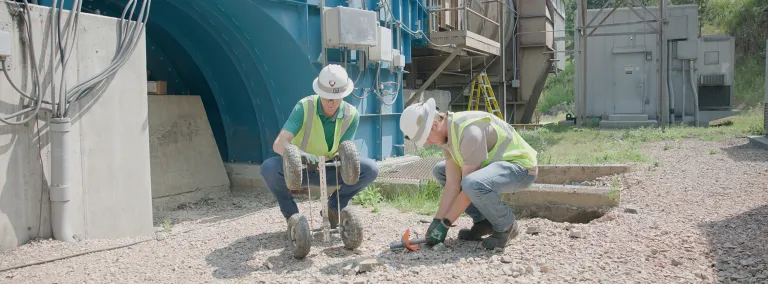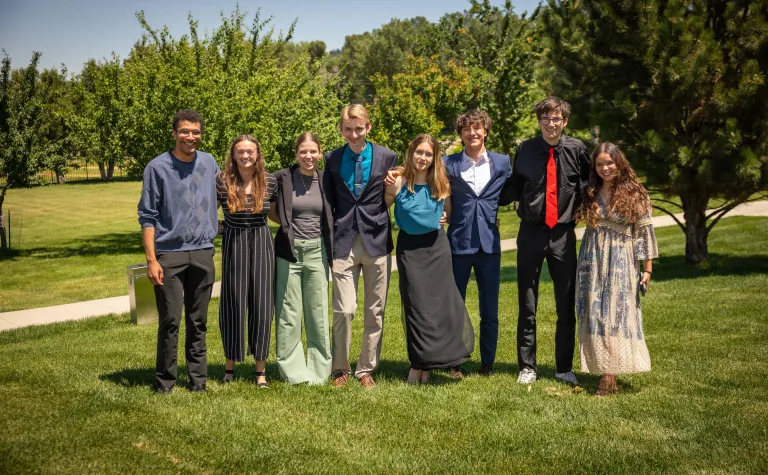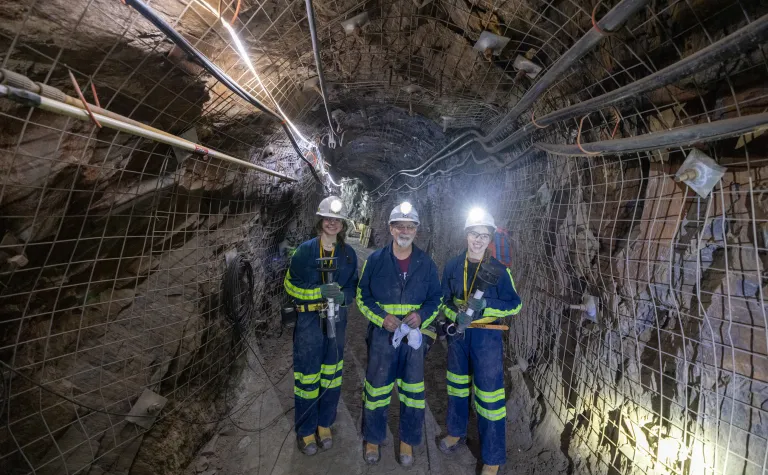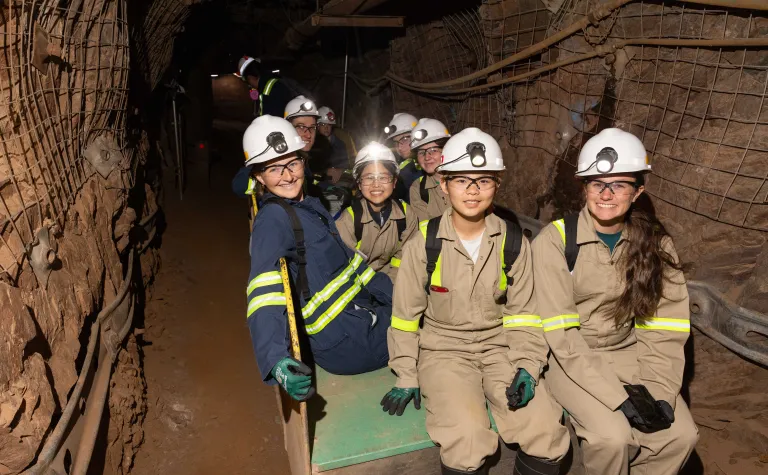SURF engineering interns design camera mount for viewing rarely seen underground spaces
A pair of summer engineering interns are aiding in the inspection of hard-to-reach areas of SURF.
The Sanford Underground Research (SURF) includes 370 miles of vertical shafts, sloped raises, and horizontal drifts that plunge to a depth of over 8000 feet below ground. Given the facility’s size, it might not be surprising to learn that there are places at SURF unsafe for people to enter.
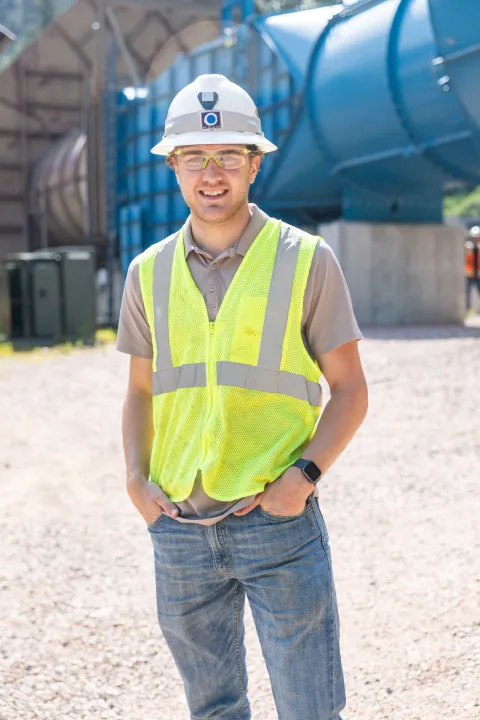
Bridger Roberdeau, a 2024 engineering intern at SURF and recipient of the Chris Bauer Engineering Internship, poses near the Oro Hondo Fan at SURF.
Photo by Stephen Kenny
Take 5-Shaft for example, it extends from the surface 6800 feet below ground. 5-Shaft was built during the former mining operation for both ventilation and conveyance to the deep underground. But after the mine closed and before SURF was established, 5-Shaft partially collapsed under wintertime ice buildup near the surface. This kind of icing is a common problem for deep mine shafts in cold weather. Five Shaft is now partially plugged with debris about 680 feet below the surface. Despite the plug, 5-Shaft is still used to exhaust air flows underground and inspecting the shaft safely poses a challenge for the engineering team at SURF. This is where a creative solution is required.
Sometimes in engineering, the best solutions are the most simple and affordable options. This is exactly what Colton Clay and Bridger Roberdeau developed. Clay grew up in Colorado and is majoring in geological engineering at South Dakota Mines. Roberdeau grew up in the nearby town of Spearfish and is majoring in mechanical engineering at LeTourneau University in Texas.
The two found an ingenious, cost-effective way to attach a relatively inexpensive GoPro 3D camera and a set of lights to a device that shields the camera all while providing a stable shot as the camera is lowered on a cable into the shaft. You can see samples of the videos that were captured by these interns who were working with a team of SURF engineers and technicians here.
“I mean, this type of hands-on work is something you don't often get in the classroom when you're just sitting at a desk. So that's been a big learning experience for me”, said Roberdeau. “It's been a really, really great opportunity,” Clay added. “I don't think there's anything like this internship in the United States. Where you get real-world experience working alongside engineers, scientists, and technicians and you get to go underground and work on and build things in support of world-class research, it’s been incredible.”
The lowering device Roberdeau and Clay helped develop proved effective in capturing video of Five Shaft and the plug of collapsed material located about 680 feet below the surface. The device also captured the deep-water pool inside Six Winze, an underground shaft that extends from the 4850 level to the 8000 level of SURF. The Six Winze is flooded to about the 5900 foot level, and the video shows the deep pool and the camera plunging below the waterline. The team also captured video of the Oro Hondo ventilation shaft, which is vital for air flow out of the underground facility.
“The interesting thing about the Oro Hondo is we've done different high-end laser scans and video scans through the years and over time the technology has really improved,” Pietzyk said. “These 3D GoPro cameras have given us another option for the video portion of surveys. They don’t take the place of a laser scan but we also get valuable images and information with these compact and affordable cameras."
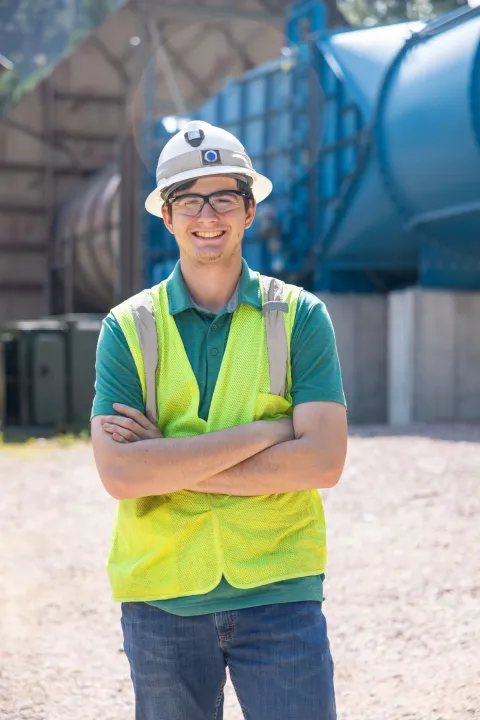
Colton Clay a 2024 engineering intern at SURF, poses in front of the Oro Hondo Fan at SURF.
Photo by Stephen Kenny.
The Number Two Air Raise at SURF proved more of a challenge to capture on video. The opening, important for underground ventilation at SURF, includes a vertical shaft that descends into a steeply sloping ramp. Therefore, simply lowering a camera on a cable won’t work once the camera hits the ramp. So, Clay and Roberdeau designed a wheeled cart to hold the camera. This way, when the cart is lowered by cable down the vertical shaft and hits the ramp below, the wheels prevent the camera from scraping, allowing the camera to roll down the slope on the cart and continue to capture images.
“We made the cart so that no matter what side it lands on, it will be able to get footage. It's preferred that it lands on the right side because the GoPro gets better images, But even if it landed upside-down, it has enough clearance so the GoPro can still capture images,” Roberdeau said. “The wheels on the car allow it to bounce along the rough surface,” Clay added.
Interns at SURF add value to their future careers with real-world experience, and the fresh viewpoint they bring to the table is also valuable for SURF.
“I appreciate the interns coming in,” Pietzyk said. “It really can give you a new way of looking at things. You might be stuck doing things the same way for years and interns bring a new perspective. The interns often have an understanding of applications for new technology, like these 3D GoPro cameras, that can add to the innovation.”
For the interns, the summer of engineering design, testing, and learning is also a lot of fun.
“It’s been really entertaining and fun to be at SURF and bounce ideas off each other as interns and the engineering team here,” Clay said. “Just being able to create and test something like this had been very enjoyable.”
The success Roberdeau and Clay found in their summer internship is an excellent example of SURF’s mission to advance world-class science and inspire learning across generations. Internship applications open each fall, and college students interested in a summer internship at SURF can find more information here.
Engineering interns at SURF benefit from the generosity of the Bauer family, honoring the memory of Chris Bauer, a dedicated engineer at SURF whose passion for innovation and mentorship continues to inspire future generations. For information on how you can support SURF’s internship program, contact the SURF Foundation.
